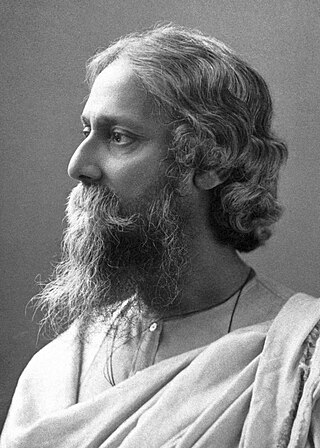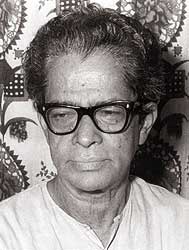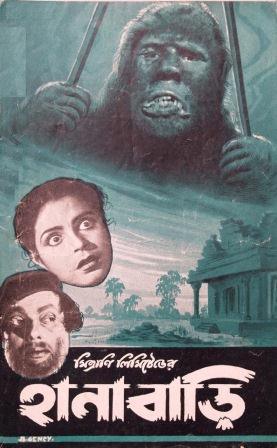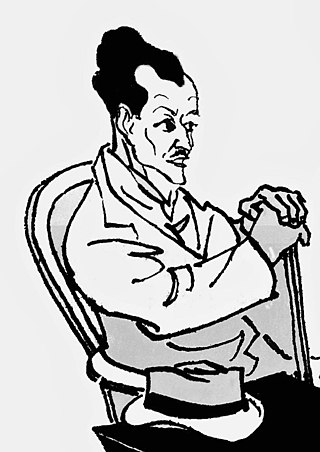Related Research Articles

Sunil Gangopadhyay or Sunil Ganguly was an Indian poet, historian and novelist in the Bengali language based in the city of Kolkata. He is a former Sheriff of Calcutta. Gangopadhyay obtained his master's degree in Bengali from the University of Calcutta. In 1953 he and a few of his friends started a Bengali poetry magazine, Krittibas. Later he wrote for many different publications.
The Hungry Generation was a literary movement in the Bengali language launched by what is known today as the Hungryalist quartet, i.e. Shakti Chattopadhyay, Malay Roy Choudhury, Samir Roychoudhury and Debi Roy, during the 1960s in Kolkata, India. Due to their involvement in this avant garde cultural movement, the leaders lost their jobs and were jailed by the incumbent government. They challenged contemporary ideas about literature and contributed significantly to the evolution of the language and idiom used by contemporaneous artists to express their feelings in literature and painting.
Byomkesh Bakshi is an Indian-Bengali fictional detective created by Sharadindu Bandyopadhyay. Referring to himself as a "truth-seeker" or Satyanweshi in the stories, Bakshi is known for his proficiency with observation, logical reasoning, and forensic science which he uses to solve complicated cases, usually murders, occurring in Calcutta. According to chronological order, Byomkesh Bakshi appeared for the first time in the story "Pother Kanta” — a story where Byomkesh shows that an assumption based on pure and simple logic is unbreakable and when we break down what is known in law as circumstantial evidence, there is nothing but logical assumptions. However his proper introduction is given in his third story, "Satyanweshi" — a story of murder dealing with illegal trafficking of cocaine. He appears in alias — under the pseudonym of Atul Chandra Mitra. It is here that Byomkesh meets Ajit Bandyopadhyay, a writer, who would become a constant companion of him and it is Ajit who narrates the Byomkesh stories.

Sharadindu Bandyopadhyay was an Indian Bengali-language writer. He was actively involved with Bengali cinema as well as Bollywood. The creator of the Bengali detective Byomkesh Bakshi, Sharadindu composed stories of a wide array of varieties including: novels, short stories, crime and detective stories, plays and screenplays. He wrote historical fiction like Kaler Mandira, Gourmollar, Tumi Sandhyar Megh, Tungabhadrar Teere, Chuya-Chandan, Maru O Sangha, Sadashib series and stories of the unnatural with the recurring character Baroda. Besides, he composed many songs and poems.

Malay Roy Choudhury is an Indian Bengali poet, playwright, short story writer, essayist and novelist who founded the Hungryalist movement in the 1960s.

Bengali literature denotes the body of writings in the Bengali language and which covers Old Bengali, Middle- Bengali and Modern Bengali with the changes through the passage of time and dynastic patronization or non-patronization. Bengali has developed over the course of roughly 1,300 years. If the emergence of the Bengali literature supposes to date back to roughly 650 AD, the development of Bengali literature claims to have 1,600 years of old. The earliest extant work in Bengali literature is the Charyapada, a collection of Buddhist mystic songs in Old Bengali dating back to the 10th and 11th centuries. The timeline of Bengali literature is divided into three periods: ancient (650–1200), medieval (1200–1800) and modern. Medieval Bengali literature consists of various poetic genres, including Hindu religious scriptures, Islamic epics, Vaishnava texts, translations of Arabic, Persian and Sanskrit texts, and secular texts by Muslim poets. Novels were introduced in the mid-19th century. Nobel laureate Rabindranath Tagore is the best known figure of Bengali literature to the world. Kazi Nazrul Islam, notable for his activism and anti-British literature, was described as the Rebel Poet and is now recognised as the National poet of Bangladesh.

Premendra Mitra was an Indian poet, writer and film director in the Bengali language. He was also a practitioner of Bengali science fiction. His critique of humanity led him to believe that for it to survive, human beings had to "forget their differences and be united".
Khagendranath Mitra (1896–1978) was a writer for children of Bengal. Even today his writings continue to be popular among children and preteens.
Ghanada Samagra 3 is a collection of Ghanada stories & novel. Written by Premendra Mitra in Bengali, this book is published by Ananda Publishers, Kolkata. This book was previously named as Ghanada Tosyo Tosyo Omnibus. It was released in 2014.

Hanabari [ Bengali: হানাবাড়ী ] is an Indian Bengali black and white thriller film released in 1952. Story, screenplay and direction were done by Bengali writer Premendra Mitra. The music director was Pabitra Chattapadhyaya. This movie was produced by Fakhrul Islam Khan in the banner of Mitrani Limited.
Gogol is a teenage fictional detective character created by Bengali writer Samaresh Basu especially for children. Few Gogol's stories were adapted into films.
Mitin Masi is a fictional Bengali female detective character created by Suchitra Bhattacharya.She is one of the most famous female detective and most read in Bengali novels.
Niladri Sarkar or Colonel Niladri Sarkar is a fictional detective character created by Bengali novelist Syed Mustafa Siraj. Some of the Colonel stories written for children were translated into English.
Shabor Dasgupta is a Bengali fictional detective character created by novelist Shirshendu Mukhopadhyay in the Goenda Shabor series. This figure is popularly known as Goenda Shabor.
Kalo Chhaya is a Bengali suspense thriller film directed by Premendra Mitra and produced by Gouranga Prasad Basu. This film was released on 17 December 1948 in the banner of Eastern Studio.
Nalini Das was a Bengali educationist, writer and editor. She was one of the editors of the Bengali children's magazine Sandesh.
Goenda Tatar is a fictional detective character created by Bengali novelist Sasthipada Chattopadhyay. Chattopadhyay wrote a number of stories of Goenda Tatar series.

Ghori is a work of science fiction written in Bengali by the novelist Premendra Mitra. This story was first published in Chhayapoth, the Puja annual of Sarat Sahityo Bhaban, Kolkata, West Bengal, India, in 1948. It was the third story in GhanaDa series portraying Ghanashyam Das alias GhanaDa, the fictional character created by Premendra Mitra, and the protagonist of the GhanaDa series of science-fiction novels.

Ghanashyam Das alias Ghanada, the protagonist of the Ghanada series of science fiction novels written in Bengali, is a fictional character created by Premendra Mitra in 1945. In the novels, the character fights evil and stands against international terrorism. The far-fetched stories take place in multiple international locations, and across a historical timeline. He is depicted regularly outwitting his fellow boarders of the mess-bari at 72, Banamali Naskar Lane, Kolkata (Calcutta). Ghanada was a personification of Premendra Mitra's anti-fascist humanistic ideologies and moral universe. His stories were notably accurate from a historical, geographical and scientific standpoint.
References
- 1 2 Premendra Mitra (2004). Parasar Samagra (Bengali). Kolkata: Ananda Publishers Pvt. Ltd. ISBN 8177563653.
- ↑ Shamik Bag. "Calcutta noir". livemint.com. Retrieved 4 June 2017.
- ↑ Premendra Mitra (1972). Har manlen Parashar Barma. Kolkata: Mitra o Ghosh Publishers.
- ↑ Premendra Mitra (1972). "Har manlen parashar barma" . Retrieved 3 September 2017.
- ↑ Premendra Mitra (1983). Rahasyavedi Parashor (Bengali). Kolkata: Pragati Library.
- ↑ "Parashare Ghanaday". ghanada.wixsite.com. Retrieved 5 June 2017.